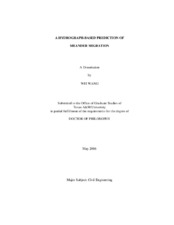| dc.description.abstract | Meander migration is a process in which water flow erodes soil on one bank and
deposits it on the opposite bank creating a gradual shift of the bank line over time. For
bridges crossing such a river, the soil foundation of the abutments may be eroded away
before the designed lifetime is reached. For highways parallel to and close to such a
river, the whole road may be eaten away. This problem is costing millions of dollars to
TxDOT in protection of affected bridges and highway embankments. This research is
aimed at developing a methodology which will predict the possible migration of a
meander considering the design life of bridges crossing it and highways parallel to it.
The approaches we use are experimental tests, numerical simulation, modeling of
migration, risk analysis, and development of a computer program.
Experimental tests can simulate river flow in a controlled environment.
Influential parameters can be chosen, adjusted, and varied systematically to quantify
their influence on the problem. The role of numerical simulation is to model the flow
field and the stress field at the soil-water interface. Migration modeling is intended to
integrate the results of experimental tests and numerical simulations and to develop a
model which can make predictions. The Hyperbolic Model is used and its two major
components Mmax equation and τmax equation are developed. Uncertainties in the
parameters used for prediction make deterministic prediction less meaningful. Risk
analysis is used to make the prediction based on a probabilistic approach. Hand
calculation is too laborious to apply these procedures. Thus the development of a user
friendly computer program is needed to automate the calculations.
Experiments performed show that the Hyperbolic Model matches the test data
well and is suitable for the prediction of meander migration. Based on analysis of shear stress data from numerical simulation, the τmax equation was derived for the Hyperbolic
Model. Extensive work on the simplification of river geometry produced a working
solution. The geometry of river channels can be automatically simplified into arcs and
straight lines. Future hydrograph is critical to risk analysis. Tens of thousands of
hydrographs bearing the same statistical characteristics as in history can be generated.
The final product that can be directly used, the MEANDER program, consists of 11,600
lines of code in C++ and 2,500 lines of code in Matlab, not including the part of risk
analysis. The computer program is ready for practice engineers to make predictions
based on the findings of this research. | en |


